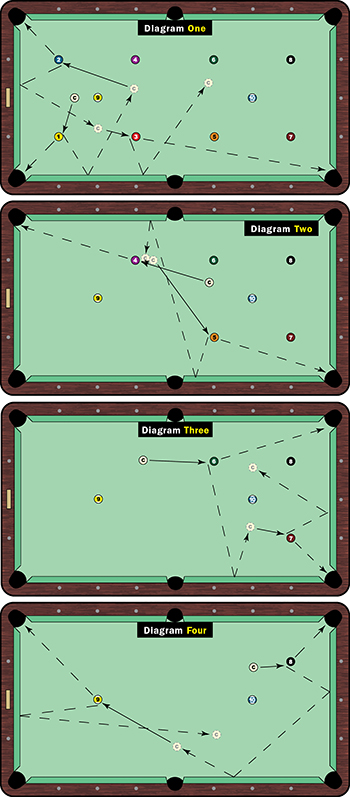The shots are easy, but the path to reach them will challenge you.
Here is another great little 10-ball pattern drill. Itís not the most difficult drill to complete, but it will force you to think through your patterns and think at least three balls ahead. I like this drill because there is plenty of room to move the cue ball around and you stay pretty much in the middle of the table.
There are plenty of options on most shots, so it will force you to think through which option offers the best and safest route. You can use a little creativity with this drill as well.
Players that have a FargoRate above 500 need to make all balls in a corner pocket. Players below 500 are allowed to use the side pockets as well. Of course, the balls must be made in rotation.
You start with ball in hand, and thatís where amateur players usually make their first mistake. They tend to simply set up a straight in stop shot on the 1 ball and then cut the 2 without thinking of getting the proper angle for the 3 ball. The problem with that is the angle off the 2 ball is on a line that leads to a very small target. They immediately lose position or worse, scratch in the opposite side pocket after cutting the 2. Thatís why I always tell players to look at least three balls ahead. I always tell players to play shots that will allow you to take the side pockets out of play.

I play this first shot (Diagram One) with just a touch of left to come to the middle of the table for the 2. Then I would use follow with a touch of left to leave an angle on the 3 ball to the upper corner. That will allow me to get on the right side of the 4 and keep the cue ball around the center of the table. Again, Iím thinking now about the 3, 4 and 5 balls.
When I attempted this drill at home, I ended up straight on the 4 ball (Diagram Two). In instances like this you have to survey your options. Instead of trying anything crazy, I simply killed the shot, pinching the 4 into the corner and keeping the cue ball away from the side rail. Sometimes you just have to take what the table gives you and trust your stroke.
Again, several options going from the 5 to the 6, but I chose to let my stroke out a bit and use two rails. To try to roll the 5 in with a little right and come off one rail makes the shot a little nervier and increases the chances of missing the shot.
Same with the 6 ball (Diagram Three). I could kill the cue ball with a soft draw or let my stroke out and use the side rail.
I could come two rails around the 8 ball after making the 7, but itís easy to lose position this way and you could get really close to the 8. I prefer to stay close to my work. I would baby this and come off one rail. It leaves a long reach for the 8 and you may have to use the bridge, but youíre left with a pretty easy shot on the 8.
From the 8 ball to the 9 (Diagram Four) is a pretty easy two-rail shot for position on the 9. You donít want to be too straight on this shot.
When there is not much angle on a shot like the 9, and you have to come back up table for the 10, I see a lot of players try to punch the 9 in. To me, itís too easy to land in the middle of the table and leave a thin cut on the 10 ball. Keep it simple and take all the pockets out of play. Just use follow with a hair of left and feel the speed to leave an easy shot on the 10.
But donít fall asleep on the money ball. Iíve seen too many players roll this ball in, which is dangerous because the possibility of a skid could be enough to throw the 10 offline. I like to punch my balls in or draw to avoid any skids.
Expect to have to use your creativity to recover on some shots. No one plays perfect patterns all the time. Stick to the process.





